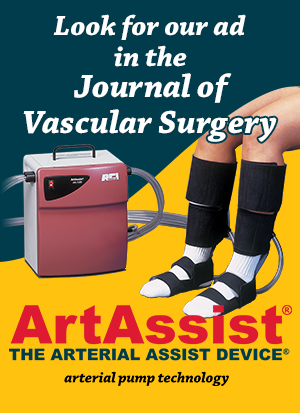Peripheral Arterial Disease
Peripheral Arterial Disease (PAD) of the lower extremities is a condition in which the arteries in the legs begin to narrow, resulting in a reduction of blood flow. PAD is caused by atherosclerosis, which is plaque build-up or “hardening of the arteries.”
What are the risk factors?
- Smoking
- Diabetes
- Over Age 50
- High Cholesterol
- High Blood Pressure (hypertension)
- Family history
Stages of PAD
Early-stage symptoms of PAD may include pain, cramps or a tired-feeling in the calf or thigh, triggered by walking and relieved by rest. This is called Intermittent Claudication.
Eventually, the artery may become so narrowed or completely blocked that the blood can no longer flow freely and you may feel pain, even at rest. This is called Rest Pain. Without a sufficient supply of oxygen, tissue (such as skin) below the blockage may die, resulting in ulceration & gangrene.
How circulation becomes impaired
A healthy artery
Arteries are vessels that deliver oxygenated blood throughout your body.
Note:
- Smooth inner wall
- Blood flow passes freely
A narrowed artery
When plaque build-up develops on the artery walls, blood flow is partially blocked. During  activity, your muscles may not receive enough oxygen during walking, causing Intermittent Claudication.
activity, your muscles may not receive enough oxygen during walking, causing Intermittent Claudication.
Note:
- Plaque build-up in artery walls
- Blood flow is partially blocked
A blocked artery
Blood flow may be completely blocked by plaque or by a blood clot that lodges in a severely narrowed artery. Without treatment, the entire foot or part of the leg may be lost to disease.
Note:
- Artery completely blocked
- Experiencing Rest Pain
- Ulcers that are difficult to heal
Different Treatment Options
- Exercise Programs/Lifestyle Changes
- Drugs
- Endovascular Surgery
- Open Surgery, or Bypass
- ArtAssist®…The Arterial Assist Device®
If a patient is in the early stages of PAD, physicians are most likely to recommend lifestyle changes such as dieting and exercise to lower cholesterol levels and stop plaque build-up in the arteries. Physicians may also prescribe medication to help manage pain and to facilitate blood flow.
New drug therapies have been effective in improving walking distances in patients with Intermittent Claudication; however, the added walking distance is small and there are those who cannot tolerate the side effects. In addition, the benefits of these drugs are lost after they are no longer taken, so a patient may be using these drugs for life – an expensive proposition.
Due to the risks of surgery, patients with Intermittent Claudication are not usually offered an operation that bypasses the blockage, using either their vein in the leg or a synthetic tube called a graft.
If the disease’s severity progresses, your physician may refer you to an endovascular surgeon. Endovascular surgery is minimally invasive and means a shorter post-operative recovery time. Many techniques are used in this growing field.
In the most severe cases of PAD, where a patient may have Rest Pain or diabetic/arterial ulcers, surgery to open or bypass the obstruction is often the best therapy, usually with good long-term results. However, there are some patients who cannot undergo the surgery or in whom the surgery has already failed.

Now patients have another option: ArtAssist®…The Arterial Assist Device®. It is a simple, effective and advanced medical device that a patient can use at home to increase blood flow.
Permanent improvement is possible through arteriogenesis, the opening of small bypass arteries.








